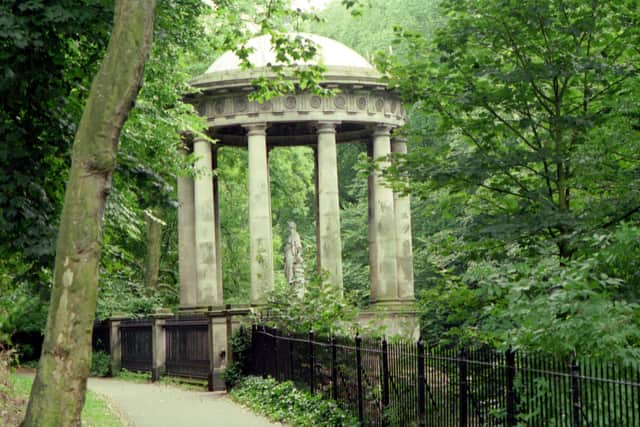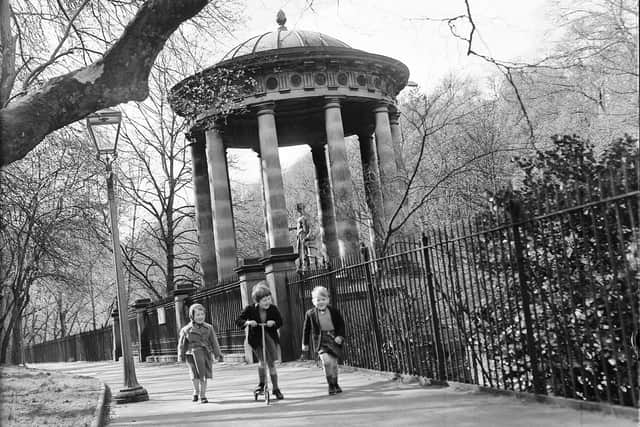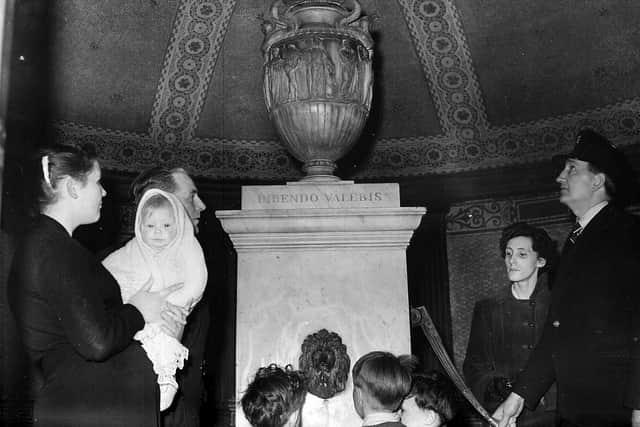The once famous healing waters of Edinburgh’s St Bernard’s Well
There was a time when the curative contents of St Bernard’s Well enjoyed a status that extended far beyond its home on the bonnie banks of the Water of Leith, with the mock-Roman temple deemed worthy of inclusion in Mary Shelley’s Frankenstein.
The well, so the story goes, was rediscovered in 1760 by a trio of George Heriot’s schoolboys who were out fishing around what is now the Dene walkway between Stockbridge and the Dean Village.
Advertisement
Hide AdAdvertisement
Hide AdBut its origins, according to legend, stretch back much further, to the 12th century, and involve St Bernard of Clairvaux, the founder of the Cistercian Order.
As part of his preparations for the Second Crusade, St Bernard is said to have set up camp for a spell in a cave near the Water of Leith, where he claimed a local spring possessed curative properties.
In September 1760, the natural spring was covered over by a well house. Contemporary poet James Wilson, who penned his works under the pseudonym Claudero, composed a eulogy for the occasion.
The Claudero wrote: “This water so healthful near Edinburgh doth rise; which not only Bath but Moffat outvies; It cleans the intestines and an appetite gives while morbfic matters it quite away drives.'"
A number of years later, in 1788, a wealthy Morningside lawyer, Lord Gardenstone, commissioned the painter Alexander Nasmyth to design a more befitting structure to mark the site of the spring.


Gardenstone, an eccentric fellow who is said to have shared his bed chamber with piglets, was an adherent of the well himself.
He envisaged a circular Roman temple based on the 1st century AD Temple of Vesta at Tivoli and dedicated to Hygeia, the goddess of health.
Situated in the midst of the well’s ten Doric columns was placed a statue of Hygeia made of Coade stone sourced from Mrs Eleanor Coade’s Artificial Stone Manufactory in London.
Advertisement
Hide AdAdvertisement
Hide AdVandalised and deemed too large for its setting, the original Coadestone statue was replaced more than a century later in 1888 by a new statue of Hygeia cut from Carrara marble by David Watson Stevenson as part of a major renovation paid for by the renowned Edinburgh publisher William Nelson.


Popularity
Word of St Bernard’s Well spread fast and it was soon compared to the famous sulphur springs at Harrogate in Yorkshire, becoming something of a mecca for the nation’s ill and infirm and indeed anyone who believed in the existence of curative springs.
So great was the well’s popularity that it’s said accommodation was at a premium in nearby Stockbridge during the summer months.
Gardenstone employed a custodian to oversee his well, charging members of the public a penny per glass and half price for children.


Consumers were told to take a brisk walk immediately after “taking the waters” and away from the well. It is thought this was done primarily as a means of clearing the path for more customers.
Mary Shelley’s Frankenstein
St Bernard’s fame was such that it is reported the writers Thomas Carlyle and Mary Shelley were disciples.
A fleeting reference of the well can even be found in chapter 19 of Shelley’s legendary magnum opus, in which Victor Frankenstein details the great sights and landmarks of Edinburgh.
Speaking of his travelling companion Henry Clerval, Dr Frankenstein states: “The beauty and regularity of the new town of Edinburgh, its romantic castle and its environs, the most delightful in the world, Arthur’s Seat, St Bernard’s Well, and the Pentland Hills... filled him with cheerfulness and admiration.”
Advertisement
Hide AdAdvertisement
Hide AdLater in the century, the Doric rotunda of the well was woven into the club badge of the now defunct St Bernard’s Football Club, whose players must surely have quenched their collective thirst at the spring in 1895, when the club punched above its weight to lift the Scottish Cup.
Though its contents were for a time bottled and sold by city chemists, those who tasted from St Bernard’s Well were not always satisfied.
One visitor to the spring described its contents as resembling the “washings of a foul gun barrel”. Another complained it had the “odious twang of hydrogen”.
Closure and restoration
Despite the pump room’s inscribed motto, Bibendo Valeris - drink and you will be well - the end for the well as a viable source of drinking water came in 1956 when city health officials discovered it was contaminated and duly locked it up.
While the well was famed for its restorative qualities, reportedly curing everything from back pain to gout and blindness, it was unable to heal itself.
By the beginning of the 2010s the Georgian building was in dire need of a touch up.
St Bernard’s Well underwent a £232,000 restoration in 2012 as part of the Twelve Monuments project driven by Edinburgh World Heritage.
Examination of the decorative pine cone on top of the roof revealed traces of a primer used to provide a stable base for applying gold leaf. Extra cash was donated to have the pine cone re-gilded.
Advertisement
Hide AdAdvertisement
Hide AdThe restored well is occasionally opened to the public on certain days throughout the year.
A message from the Editor:
Thank you for reading this story on our website. While I have your attention, I also have an important request to make of you.
With the coronavirus lockdown having a major impact on many of our advertisers - and consequently the revenue we receive - we are more reliant than ever on you taking out a digital subscription.
Subscribe to scotsman.com and enjoy unlimited access to Scottish news and information online and on our app. With a digital subscription, you can read more than 5 articles, see fewer ads, enjoy faster load times, and get access to exclusive newsletters and content. Visit https://www.scotsman.com/subscriptions now to sign up.
Our journalism costs money and we rely on advertising, print and digital revenues to help to support them. By supporting us, we are able to support you in providing trusted, fact-checked content for this website.
Joy Yates
Editorial Director
Comments
Want to join the conversation? Please or to comment on this article.